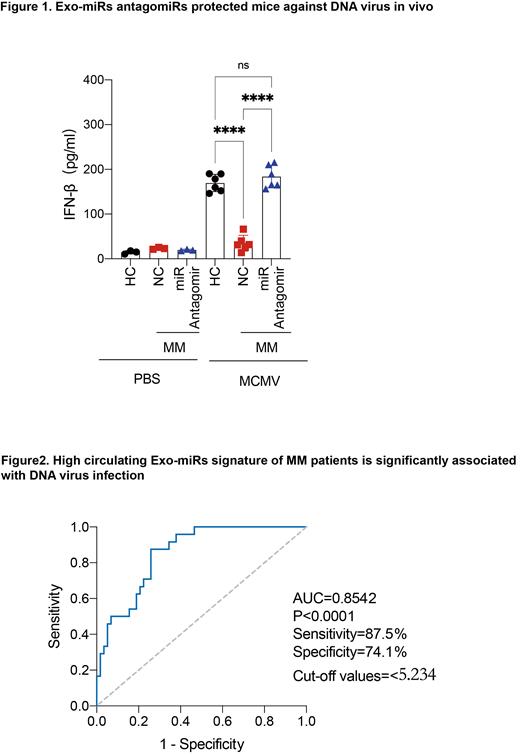Introduction
DNA virus infection is a significant cause of morbidity and mortality in patients with multiple myeloma (MM). Monocyte dysfunction in MM patients plays a central role in infectious complications, but the precise molecular mechanism underlying the reduced monocyte resistance to viruses and risk factors for infection in newly diagnosed MM patients remains to be elucidated.
Methods
To determine the role of exosomal miRNAs in DNA infection of MM patients, we analyzed miRNAs in BM exosomes from MM patients (Exo-miRs) using high-throughput small RNA sequencing. To further evaluate the effect of these five upregulated Exo-miRs in antiviral response, we transfected the host cells with chemically synthesized miRNAs mimics to overexpress miRNAs. We utilized qPCR and WB to characterize the fate the cGAS-STING signaling pathway of THP-1 after overexpress miRNAs. The efficacy and safety of these Exo-miRs in innate antiviral immunity were evaluated using 5TGM1 C57BL/KaLwRij mice models. Additionally, miRNAs copy number as well as the viral susceptibility of newly diagnosed MM patients were determined in 82 samples from newly diagnosed biopsy proven MM patients.
Results
Screening of miRNAs enriched in exosomes delivered by primary MM cells identified five miRNAs as inhibitory factors that negatively regulate the cGAS-STING antiviral immune response. When engraftments of 5TGM1-Luc cells via tail vein for eight weeks in C57BL/KaLwRij mice resulted in MM progression with typical MM phenotypes, model mice were primed with Exo-miR antagomiRs oligonucleotides mixture through tail vein injection three times every 24 h followed by Murine cytomegalovirus (MCMV) challenge for 36 h. Consistent with the immunosuppression in MM patients, 5TGM1 C57BL/KaLwRij mice showed lower IFN-β in sera. Notably, intravenous administration of antagomiRs against miRNAs resulted in a marked increase of IFN-β levels in serum and IFN-I expression in organs (Figure 1).
To investigate the potential of the miR-score as a prognostic determinant of vulnerability to DNA virus infection, we compared the miR-score in plasma exosomes collected from 82 newly diagnosed biopsy proven MM patients. We classified the viral susceptibility of newly diagnosed MM patients into two groups: I, DNA virus infection; II, no DNA virus infection. In human, a pronounced inverse correlation between IFN-β production by DNA virus in PBMCs and the microRNA (miR)-score of the exosomes within the plasma. The patients with DNA virus infection showed significantly enhanced circulatory expression of miRNAs than without DNA virus infection (p<0.001) patients. The diagnostic potential of miRNAs was assessed by plotting ROC curve, 5 miRNAs showed optimum sensitivity and specificity(AUC 0.854, P<0.0001, Sensitivity 87.5%, Specificity 74.1%, Cut-off values 5.234)(Figure 2).
Conclusions
These findings identify a mechanism by which MM cells can suppress the host's innate immunity and potentially lead to immunocompromise in MM patients. Furthermore, the aberrant expression of specific miRNAs in MM patients emerges as a potential therapeutic target in MM cells. By quantifying miRNA scores based on abundant exosomal miRNAs in peripheral blood, the risk of DNA virus infection in MM patients can be assessed. Our findings shed light on a previously unknown molecular mechanism underlying immunosuppression in MM patients who have not received antineoplastic therapy, and also reveal a distinct miRNA signature that serves as a crucial determinant of the susceptibility of newly diagnosed MM patients to DNA virus infections.
Disclosures
No relevant conflicts of interest to declare.


This feature is available to Subscribers Only
Sign In or Create an Account Close Modal